Active Carboxymethyl Cellulose-Based Edible Coatings for the Extension of Fresh Goldenberries Shelf-Life †
Abstract
1. Introduction
2. Materials and Methods
2.1. Raw Material and Chemicals
2.2. Coating Production
2.3. Surface Tension and Critical Surface Tension of Goldenberry Skin
2.4. Selection of Coating Solutions
2.4.1. Wettability
2.4.2. Antimicrobial Activity
2.5. Application of the Coating on Goldenberries
2.6. Gas Exchange Rates
2.7. Physicochemical and Microbiological Properties
2.7.1. Weight Loss
2.7.2. pH
2.7.3. Acidity
2.7.4. Total Soluble Solids
2.7.5. Browning
2.7.6. Vitamin C
2.7.7. Phenolic Compounds and Flavonoids
2.7.8. Microbiological Analysis
2.8. Sensorial Analysis
2.9. Statistical Analysis
3. Results
3.1. Surface Tension and Critical Surface Tension of Goldenberry Skin
3.2. Selection of Coating Solutions
3.2.1. Wettability
3.2.2. Antimicrobial Activity
3.3. Evaluation of CMC-Based Coatings on Fresh Goldenberry
3.3.1. Gas Exchange Rates
3.3.2. Weight Loss
3.3.3. pH and Acidity
3.3.4. Total Soluble Solids and Browning
3.3.5. Vitamin C, Phenolic Compounds and Flavonoids
3.3.6. Microbiological Analysis
3.3.7. Sensorial Analysis
4. Conclusions
Author Contributions
Funding
Data Availability Statement
Acknowledgments
Conflicts of Interest
References
- Dotto, G.L.; Vieira, M.L.G.; Pinto, L.A.A. Use of Chitosan Solutions for the Microbiological Shelf Life Extension of Papaya Fruits during Storage at Room Temperature. LWT-Food Sci. Technol. 2015, 64, 126–130. [Google Scholar] [CrossRef]
- Li, H.; Li, F.; Wang, L.; Sheng, J.; Xin, Z.; Zhao, L.; Xiao, H.; Zheng, Y.; Hu, Q. Effect of Nano-Packing on Preservation Quality of Chinese Jujube (Ziziphus jujuba Mill. Var. inermis (Bunge) Rehd). Food Chem. 2009, 114, 547–552. [Google Scholar] [CrossRef]
- Souza, M.P.; Vaz, A.F.M.; Cerqueira, M.A.; Texeira, J.A.; Vicente, A.A.; Carneiro-da-Cunha, M.G. Effect of an Edible Nanomultilayer Coating by Electrostatic Self-Assembly on the Shelf Life of Fresh-Cut Mangoes. Food Bioprocess Technol. 2015, 8, 647–654. [Google Scholar] [CrossRef]
- Cerqueira, M.A.; Lima, Á.M.; Teixeira, J.A.; Moreira, R.A.; Vicente, A.A. Suitability of Novel Galactomannans as Edible Coatings for Tropical Fruits. J. Food Eng. 2009, 94, 372–378. [Google Scholar] [CrossRef]
- Flores-López, M.L.; Cerqueira, M.A.; de Rodríguez, D.J.; Vicente, A.A. Perspectives on Utilization of Edible Coatings and Nano-Laminate Coatings for Extension of Postharvest Storage of Fruits and Vegetables. Food Eng. Rev. 2016, 8, 292–305. [Google Scholar] [CrossRef]
- Licodiedoff, S.; Koslowski, L.A.D.; Scartazzini, L.; Monteiro, A.R.; Ninow, J.L.; Borges, C.D. Conservation of Physalis by Edible Coating of Gelatin and Calcium Chloride. Int. Food Res. J. 2016, 23, 1629–1634. [Google Scholar]
- Ballesteros, L.F.; Michelin, M.; Vicente, A.A.; Teixeira, J.A.; Cerqueira, M.Â. Food Applications of Lignocellulosic-Based Packaging Materials. In Lignocellulosic Materials and Their Use in Bio-Based Packaging; Navard, P., Ed.; Springer International Publishing: Cham, Switzerland, 2018; pp. 87–94. [Google Scholar]
- Lin, D.; Zhao, Y. Innovations in the Development and Application of Edible Coatings for Fresh and Minimally Processed Fruits and Vegetables. Compr. Rev. Food Sci. Food Saf. 2007, 6, 60–75. [Google Scholar] [CrossRef]
- Cerqueira, M.A.; Lima, Á.M.; Souza, B.W.S.; Teixeira, J.A.; Moreira, R.A.; Vicente, A.A. Functional Polysaccharides as Edible Coatings for Cheese. J. Agric. Food Chem. 2009, 57, 1456–1462. [Google Scholar] [CrossRef]
- Cerqueira, M.A.; Teixeira, J.A.; Vicente, A.A. Edible Packaging Today. In Edible Food Packaging Materials and Processing Technologies; Cerqueira, M.A., Pereira, R.N., Ramos, O., Teixeira, J.A., Vicente, A.A., Eds.; CRC Press Taylor & Francis Group: Boca Raton, FL, USA, 2016; pp. 1–8. [Google Scholar]
- Salas-Méndez, E.d.J.; Vicente, A.; Pinheiro, A.C.; Ballesteros, L.F.; Silva, P.; Rodríguez-García, R.; Hernández-Castillo, F.D.; Díaz-Jiménez, M.d.L.V.; Flores-López, M.L.; Villarreal-Quintanilla, J.Á.; et al. Application of Edible Nanolaminate Coatings with Antimicrobial Extract of Flourensia Cernua to Extend the Shelf-Life of Tomato (Solanum lycopersicum L.) Fruit. Postharvest Biol. Technol. 2019, 150, 19–27. [Google Scholar] [CrossRef]
- Khalil, R.K.S.; Sharaby, M.R.; Abdelrahim, D.S. Novel Active Edible Food Packaging Films Based Entirely on Citrus Peel Wastes. Food Hydrocoll. 2023, 134, 107961. [Google Scholar] [CrossRef]
- Ballesteros, L.F.; Cerqueira, M.A.; Teixeira, J.A.; Mussatto, S.I. Production and Physicochemical Properties of Carboxymethyl Cellulose Films Enriched with Spent Coffee Grounds Polysaccharides. Int. J. Biol. Macromol. 2018, 106, 647–655. [Google Scholar] [CrossRef]
- Ballesteros, L.F.; Michelin, M.; Vicente, A.A.; Teixeira, J.A.; Cerqueira, M.Â. Use of Lignocellulosic Materials in Bio-Based Packaging Packaging. In Lignocellulosic Materials and Their Use in Bio-Based Packaging; Navard, P., Ed.; Springer International Publishing: Cham, Switzerland, 2018; pp. 65–86. [Google Scholar]
- Ballesteros, L.F.; Cerqueira, M.A.; Teixeira, J.A.; Mussatto, S.I. Characterization of Polysaccharides Extracted from Spent Coffee Grounds by Alkali Pretreatment. Carbohydr. Polym. 2015, 127, 347–354. [Google Scholar] [CrossRef]
- Ballesteros, L.F.; Teixeira, J.A.; Mussatto, S.I. Extraction of Polysaccharides by Autohydrolysis of Spent Coffee Grounds and Evaluation of Their Antioxidant Activity. Carbohydr. Polym. 2017, 157, 258–266. [Google Scholar] [CrossRef]
- Ballesteros, L.F.; Teixeira, J.A.; Mussatto, S.I. Chemical, Functional, and Structural Properties of Spent Coffee Grounds and Coffee Silverskin. Food Bioprocess Technol. 2014, 7, 3493–3503. [Google Scholar] [CrossRef]
- Ballesteros, L.F.; Ramirez, M.J.; Orrego, C.E.; Teixeira, J.A.; Mussatto, S.I. Encapsulation of Antioxidant Phenolic Compounds Extracted from Spent Coffee Grounds by Freeze-Drying and Spray-Drying Using Different Coating Materials. Food Chem. 2017, 237, 623–631. [Google Scholar] [CrossRef]
- Ballesteros, L.F.; Ramirez, M.J.; Orrego, C.E.; Teixeira, J.A.; Mussatto, S.I. Optimization of Autohydrolysis Conditions to Extract Antioxidant Phenolic Compounds from Spent Coffee Grounds. J. Food Eng. 2017, 199, 1–8. [Google Scholar] [CrossRef]
- Galindez, A.; Daza, L.D.; Homez-Jara, A.; Sandoval-Aldana, A.; Váquiro, H.A. Effect of Ulluco Starch Coating on the Preservation of Harvested Goldenberries (Physalis peruviana L.). J. Food Process. Preserv. 2021, 45, e16071. [Google Scholar] [CrossRef]
- Zhang, Y.-J.; Deng, G.-F.; Xu, X.-R.; Wu, S.; Li, S.; Li, H.-B. Chemical Components and Bioactivities of Cape Gooseberry (Physalis Peruviana). Int. J. Food Nutr. Saf. 2013, 3, 15–24. Available online: www.ModernScientificPress.com/Journals/IJFNS.aspx (accessed on 25 May 2022).
- Pedro Carvalho, C.; Villaño, D.; Moreno, D.A.; Serrano, M.; Valero, D. Alginate Edible Coating and Cold Storage for Improving the Physicochemical Quality of Cape Gooseberry (Physalis peruviana L.). Food Sci. Nutr. 2015, 1, 1–7. [Google Scholar] [CrossRef][Green Version]
- Puente, L.A.; Pinto-Muñoz, C.A.; Castro, E.S.; Cortés, M. Physalis peruviana L., the Multiple Properties of a Highly Functional Fruit: A Review. Food Res. Int. 2011, 44, 1733–1740. [Google Scholar] [CrossRef]
- Castro, R.A.; Blair, G.H.G. Evaluación Fisicoquímica de La Efectividad de Un Recubrimiento Comestible En La Conservación de Uchuva (Physalis peruviana Var. Colombia). Aliment. Hoy 2010, 19, 16–34. [Google Scholar]
- Peretto, G.; Du, W.X.; Avena-Bustillos, R.J.; Sarreal, S.B.L.; Hua, S.S.T.; Sambo, P.; McHugh, T.H. Increasing Strawberry Shelf-Life with Carvacrol and Methyl Cinnamate Antimicrobial Vapors Released from Edible Films. Postharvest Biol. Technol. 2014, 89, 11–18. [Google Scholar] [CrossRef]
- SemperfreshTM, Pace-International. The Leader in Postharvest Solutions. Available online: https://www.paceint.com/product/semperfresh/ (accessed on 30 May 2022).
- Fakhouri, F.M.; Martelli, S.M.; Caon, T.; Velasco, J.I.; Mei, L.H.I. Edible Films and Coatings Based on Starch/Gelatin: Film Properties and Effect of Coatings on Quality of Refrigerated Red Crimson Grapes. Postharvest Biol. Technol. 2015, 109, 57–64. [Google Scholar] [CrossRef]
- NatureSeal, Inc. Leading the Fresh-Cut Produce Industry by Storm. Available online: https://www.natureseal.com/ (accessed on 25 May 2022).
- Van Oss, C.J.; Chaudhury, M.K.; Good, R.J. Interfacial Lifshitz—Van Der Waals and Polar Interactions in Macroscopic Systems. Chem. Rev. 1988, 88, 927–941. [Google Scholar] [CrossRef]
- Zisman, W.A. Contact Angle, Wettability and Adhesion. In Advances in Chemistry Series; Fowkes, F.M., Ed.; American Chemical Society: Washington, DC, USA, 1964; pp. 1–51. [Google Scholar]
- Rulon, J.; Robert, H. Wetting of Low-Energy Surfaces. In Wettability; Berg, J.C., Ed.; Marcel Dekker Inc.: New York, NY, USA, 1993; pp. 4–73. [Google Scholar]
- Kwok, D.; Neumann, A. Contact Angle Measurement and Contact Angle Interpretation. Adv. Colloid Interface Sci. 1999, 81, 167–249. [Google Scholar] [CrossRef]
- Hili, P.; Evans, C.S.; Veness, R.G. Antimicrobial Action of Essential Oils: The Effect of Dimethylsulphoxide on the Activity of Cinnamon Oil. Lett. Appl. Microbiol. 1997, 24, 269–275. [Google Scholar] [CrossRef]
- Scorzoni, L.; Benaducci, T.; Almeida, A.M.F.; Silva, D.H.S.; Bolzani, V.S.; Mendes-Giannini, M.J.S. Comparative Study of Disk Diffusion and Microdilution Methods for Evaluation of Antifungal Activity of Natural Compounds against Medical Yeasts Candida Spp. and Cryptococcus Sp. Rev. Ciencias Farm. Basica Apl. 2007, 28, 25–34. [Google Scholar]
- Salvador, M.L.; Jaime, P.; Oria, R. Modeling of O2 and CO2 Exchange Dynamics in Modified Atmosphere Packaging of Burlat Cherries. J. Food Sci. 2002, 67, 231–235. [Google Scholar] [CrossRef]
- Giovanelli, G.; Limbo, S.; Buratti, S. Effects of New Packaging Solutions on Physico-Chemical, Nutritional and Aromatic Characteristics of Red Raspberries (Rubus idaeus L.) in Postharvest Storage. Postharvest Biol. Technol. 2014, 98, 72–81. [Google Scholar] [CrossRef]
- Ballesteros, L.F.; Teixeira, J.A.; Mussatto, S.I. Selection of the Solvent and Extraction Conditions for Maximum Recovery of Antioxidant Phenolic Compounds from Coffee Silverskin. Food Bioprocess Technol. 2014, 7, 1322–1332. [Google Scholar] [CrossRef]
- Food and Drug Administration. Bacteriological Analytical Manual, and Foodborne Pathogenic Microorganisms and Natural Toxins Handbook, 8th ed.; Food and Drug Administration: Tempe, AZ, USA, 1998.
- Choi, W.Y.; Park, H.J.; Ahn, D.J.; Lee, J.; Lee, C.Y. Wettability of Chitosan Coating Solution on “Fuji” Apple Skin. J. Food Sci. 2002, 67, 2668–2672. [Google Scholar] [CrossRef]
- Martins, J.T.; Cerqueira, M.A.; Souza, B.W.S.; Carmo Avides, M.D.O.; Vicente, A.A. Shelf Life Extension of Ricotta Cheese Using Coatings of Galactomannans from Nonconventional Sources Incorporating Nisin against Listeria Monocytogenes. J. Agric. Food Chem. 2010, 58, 1884–1891. [Google Scholar] [CrossRef]
- De Rodríguez, D.J.; García, R.R.; Castillo, F.D.H.; González, C.N.A.; Galindo, A.S.; Quintanilla, J.A.V.; Zuccolotto, L.E.M. In Vitro Antifungal Activity of Extracts of Mexican Chihuahuan Desert Plants against Postharvest Fruit Fungi. Ind. Crops Prod. 2011, 34, 960–966. [Google Scholar] [CrossRef]
- Ren, L.; Hemar, Y.; Perera, C.O.; Lewis, G.; Krissansen, G.W.; Buchanan, P.K. Antibacterial and Antioxidant Activities of Aqueous Extracts of Eight Edible Mushrooms. Bioact. Carbohydr. Diet. Fibre 2014, 3, 41–51. [Google Scholar] [CrossRef]
- Gutierrez, M.S.; Trinchero, G.D.; Cerri, A.M.; Vilella, F.; Sozzi, G.O. Different Responses of Goldenberry Fruit Treated at Four Maturity Stages with the Ethylene Antagonist 1-Methylcyclopropene. Postharvest Biol. Technol. 2008, 48, 199–205. [Google Scholar] [CrossRef]
- Bolzan, R.P.; Cuquel, F.L.; Lavoranti, O.J. Cold Storage of Cape Gooseberry. Rev. Bras. Frutic. 2011, 33, 577–583. [Google Scholar] [CrossRef]
- Tovar, B.; García, H.S.; Mata, M. Physiology of Pre-Cut Mango II. Evolution of Organic Acids. Food Res. Int. 2001, 34, 705–714. [Google Scholar] [CrossRef]
- Mgaya-Kilima, B.; Remberg, S.F.; Chove, B.E.; Wicklund, T. Influence of Storage Temperature and Time on the Physicochemical and Bioactive Properties of Roselle-fruit Juice Blends in Plastic Bottle. Food Sci. Nutr. 2014, 2, 181–191. [Google Scholar] [CrossRef]
- Souza, B.W.S.; Cerqueira, M.A.; Martins, J.T.; Casariego, A.; Teixeira, J.A.; Vicente, A.A. Influence of Electric Fields on the Structure of Chitosan Edible Coatings. Food Hydrocoll. 2010, 24, 330–335. [Google Scholar] [CrossRef]
- Gutiérrez, T.M.; Hoyos, O.L.; Páez, Y.M.I. Ascorbic Acid Determination in Gooseberry (Physalis peruviana L.), for High-Performance Liquid Ghromatography (HPLC). Fac. Cienc. Agropecu. 2007, 5, 70–79. [Google Scholar] [CrossRef]
- Galani, J.H.Y.; Patel, J.S.; Patel, N.J.; Talati, J.G. Storage of Fruits and Vegetables in Refrigerator Increases Their Phenolic Acids but Decreases the Total Phenolics, Anthocyanins and Vitamin C with Subsequent Loss of Their Antioxidant Capacity. Antioxidants 2017, 6, 59. [Google Scholar] [CrossRef] [PubMed]
- Juhnevica-Radenkova, K.; Radenkovs, V.; Krasnova, I. The Impact of 1-MCP Treatment and Controlled Atmosphere Storage on the Postharvest Performance of Four (Chaenomeles japonica (Thunb.) Lindl. Ex Spach) Fruit Cultivars. J. Food Process. Preserv. 2022, 46, e16193. [Google Scholar] [CrossRef]
- Valdenegro, M.; Fuentes, L.; Herrera, R.; Moya-León, M.A. Changes in Antioxidant Capacity during Development and Ripening of Goldenberry (Physalis peruviana L.) Fruit and in Response to 1-Methylcyclopropene Treatment. Postharvest Biol. Technol. 2012, 67, 110–117. [Google Scholar] [CrossRef]
- Amira, E.A.; Behija, S.E.; Beligh, M.; Lamia, L.; Manel, I.; Mohamed, H.; Lotfi, A. Effects of the Ripening Stage on Phenolic Profile, Phytochemical Composition and Antioxidant Activity of Date Palm Fruit. J. Agric. Food Chem. 2012, 60, 10896–10902. [Google Scholar] [CrossRef] [PubMed]
- Garcia, L.C.; Mendes Pereira, L.; de Luca Sarantópoulos, C.I.G.; Hublinger, M.D. Effect of Antimicrobial Starch Edible Coating on Shelf-Life of Fresh Strawberries. Packag. Technol. Sci. 2012, 25, 413–425. [Google Scholar] [CrossRef]
- Guynot, M.E.; Marín, S.; Sanchis, V.; Ramos, A.J. Modified Atmosphere Packaging for Prevention of Mold Spoilage of Bakery Products with Different PH and Water Activity Levels. J. Food Prot. 2003, 66, 1864–1872. [Google Scholar] [CrossRef]
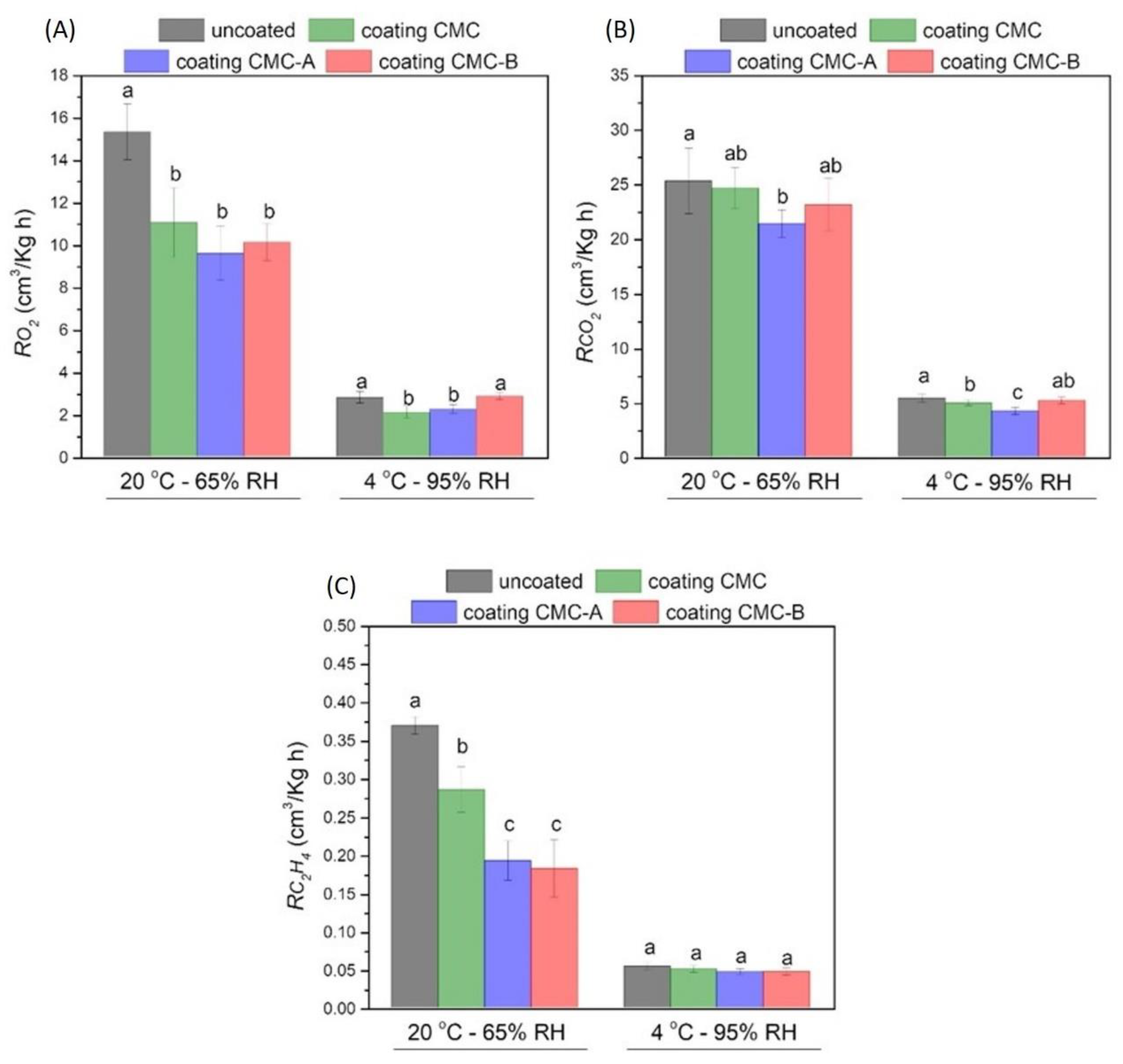
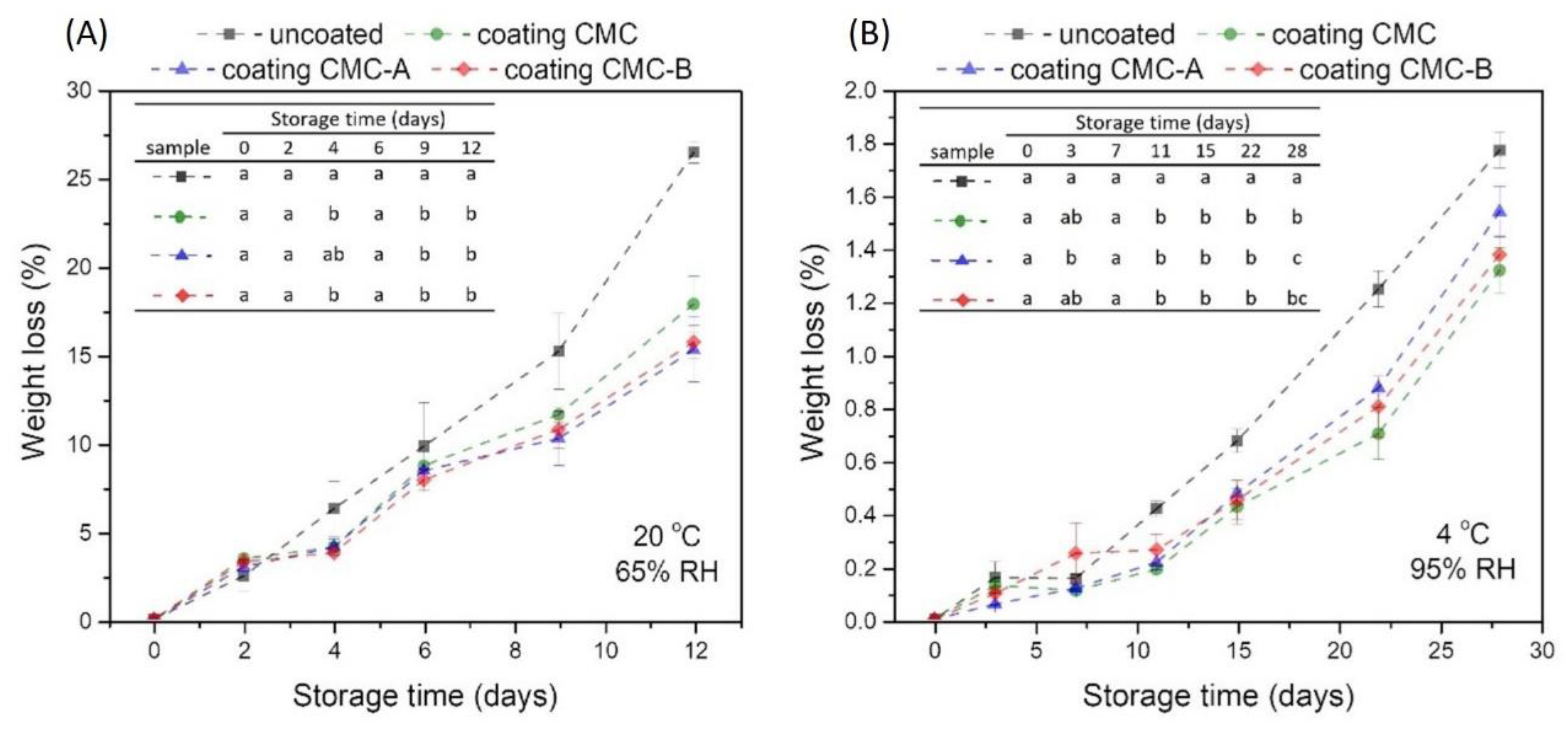
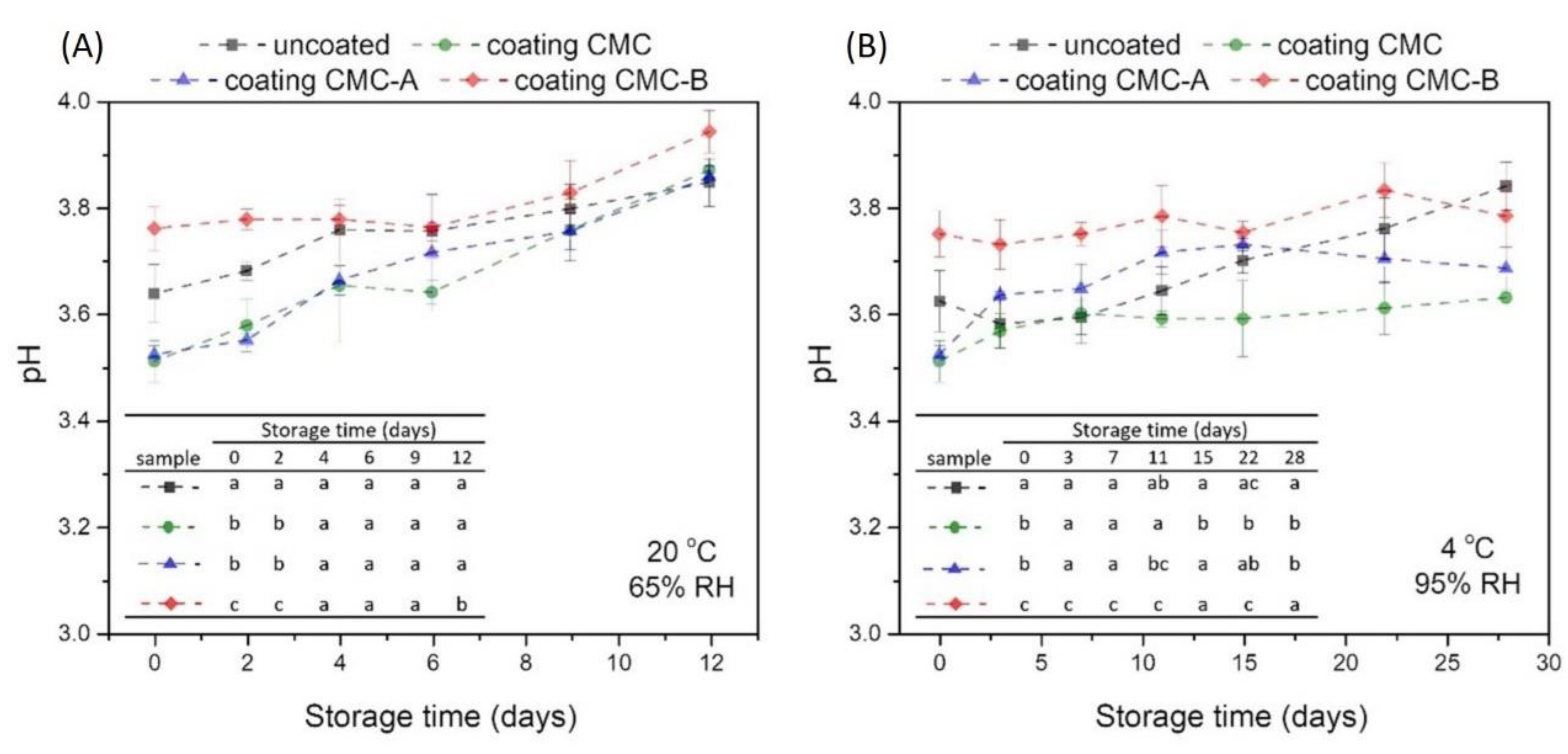
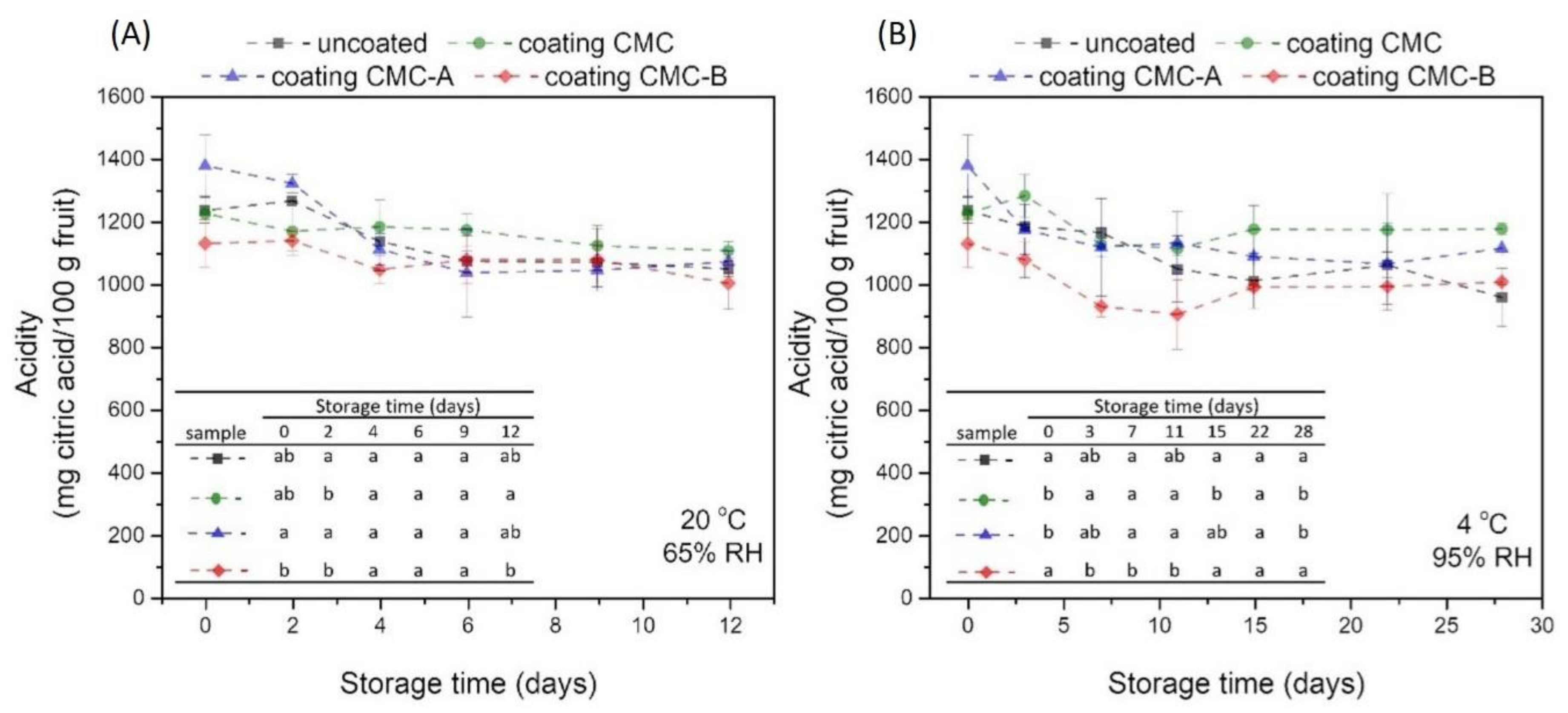
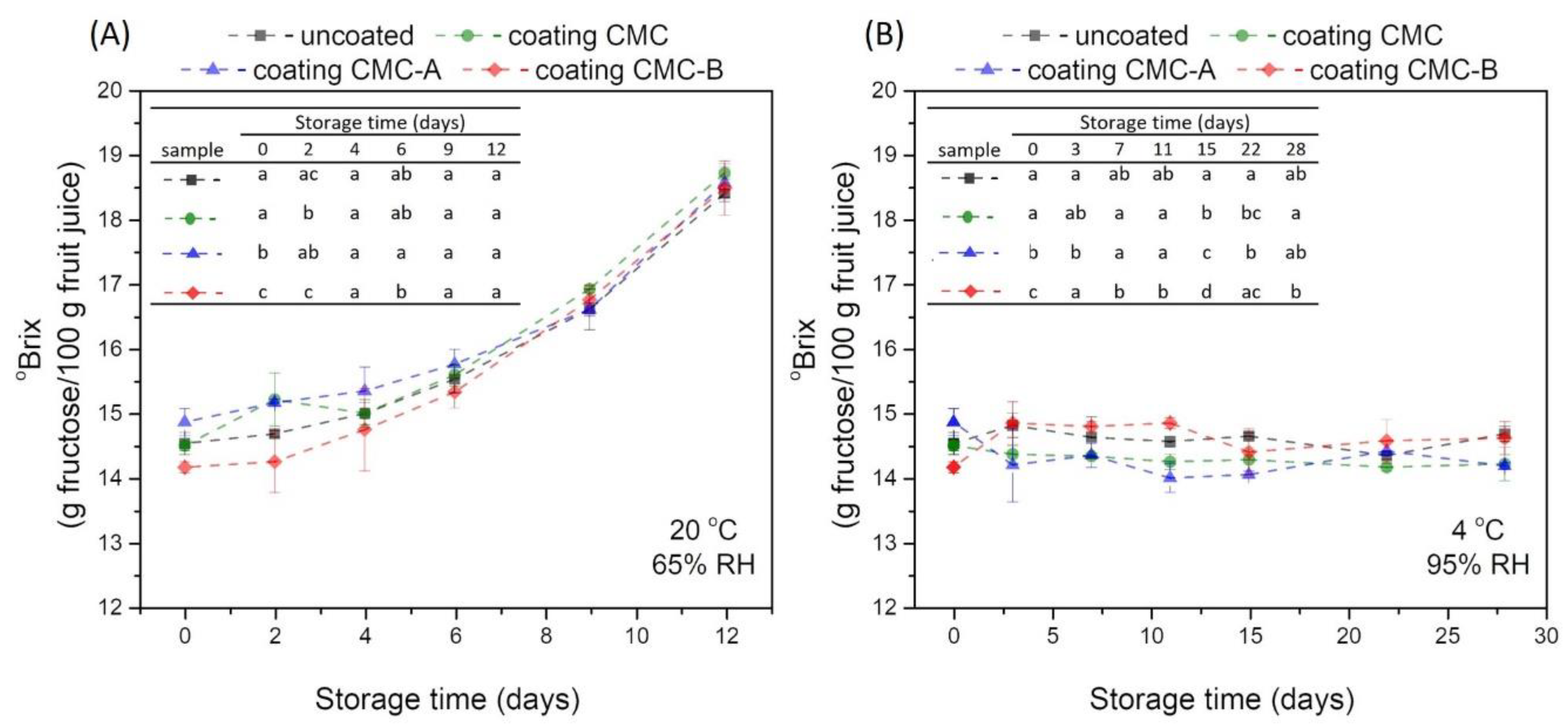
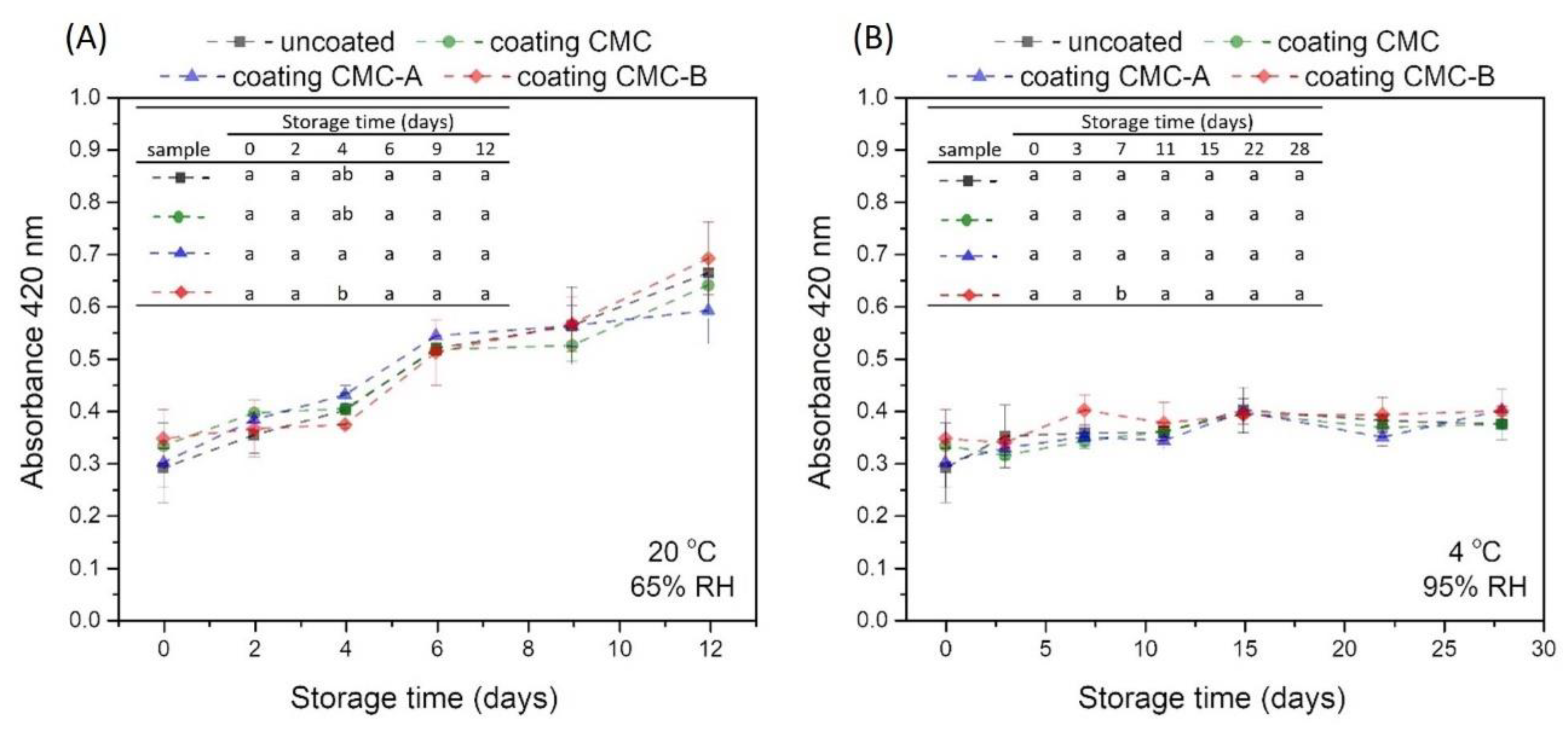
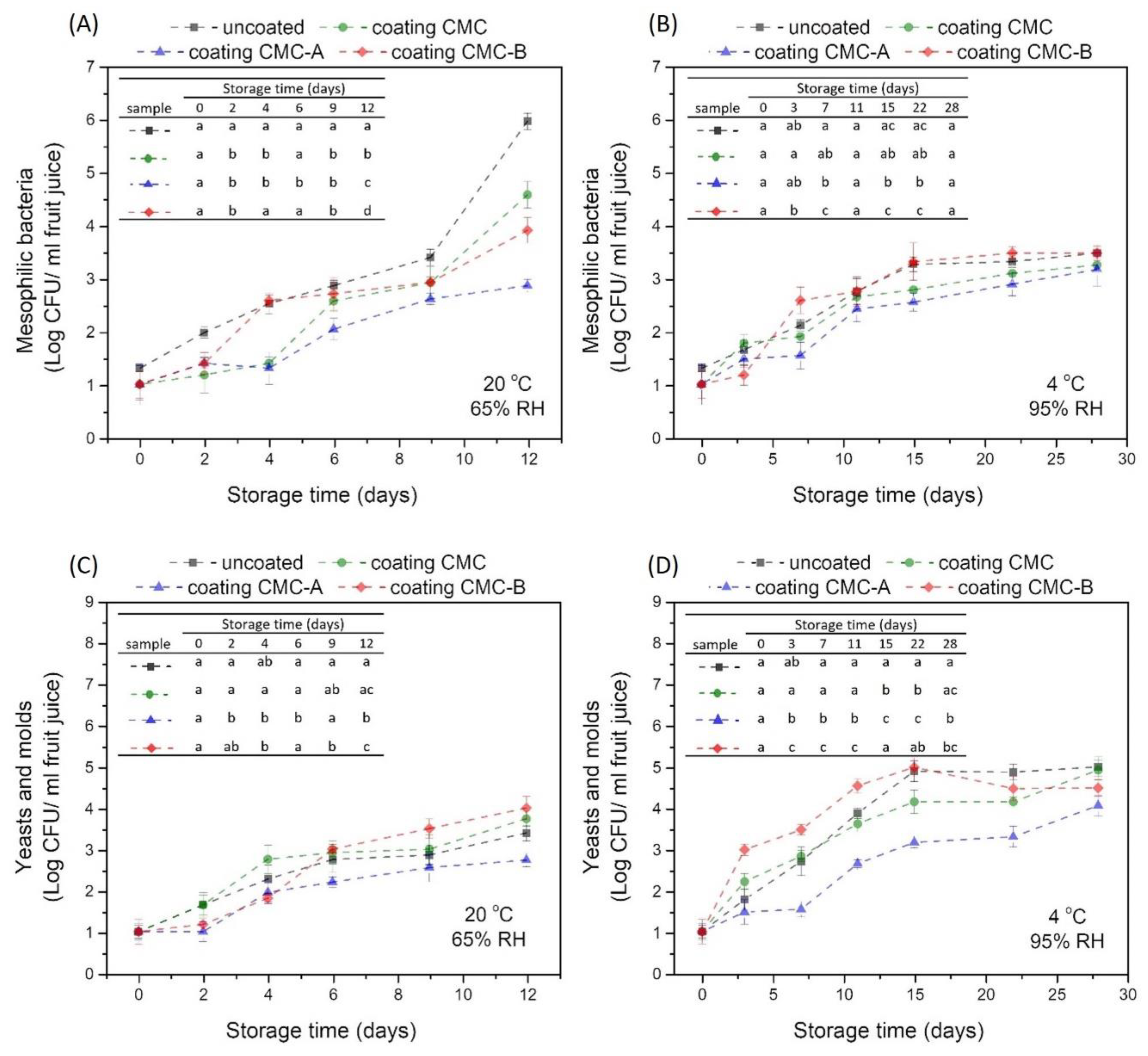
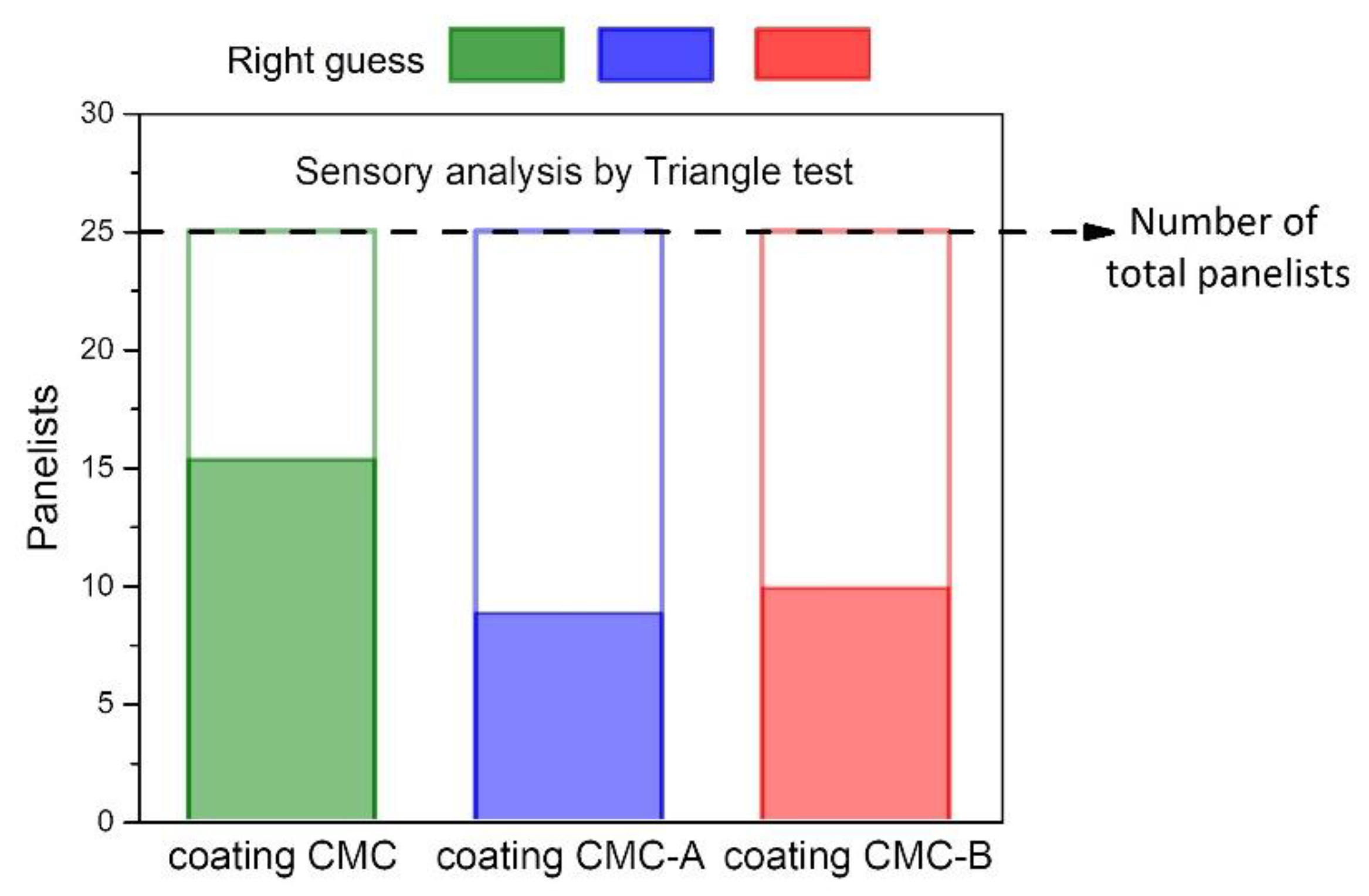
| Sample | Concentration of Polysaccharide-Rich Extract and Phenolic Compound-Rich Extract in the Coating Solutions | (mN/m) | |
|---|---|---|---|
| Polysaccharides (%, w/v) | Phenolic Compounds (%, w/v) | ||
| Coating CMC | ---- | ---- | −81.69 ± 3.36 a |
| Coatings CMC-A | 0.05 | ---- | −44.96 ± 4.21 b |
| 0.10 | ---- | −59.81 ± 5.84 c | |
| 0.20 | ---- | −35.72 ± 3.82 d | |
| Coatings CMC-B | 0.20 | 0.05 | −58.02 ± 2.30 b |
| 0.20 | 0.10 | −51.76 ± 4.87 b | |
| 0.20 | 0.20 | −44.13 ± 3.94c | |
| Sample | Concentration of Polysaccharide-Rich Extract and Phenolic Compound-Rich Extract in the Coating Solutions | Alternaria sp. | Phoma violacea | Penicillium expansum | Cladosporium cladosporioides | Fusarium culmorum | Botrytiscinerea | |
|---|---|---|---|---|---|---|---|---|
| Polysaccharides (%, w/v) | Phenolic Compounds (%, w/v) | |||||||
| Coating CMC | ---- | ---- | ||||||
| Coatings CMC-A | 0.05 | ---- | X | X | X | |||
| 0.10 | ---- | X | X | X | ||||
| 0.20 | ---- | X | X | X | X | X | X | |
| Coatings CMC-B | 0.20 | 0.05 | X | X | ||||
| 0.20 | 0.10 | X | X | |||||
| 0.20 | 0.20 | X | X | X | ||||
| Sample | Analysis | Storage Time (Days) | |||||
|---|---|---|---|---|---|---|---|
| 0 | 2 | 4 | 6 | 9 | 12 | ||
| Uncoated | Vit C | 22.88 ± 0.62 a | 28.23 ± 2.27 a | 30.85 ± 1.05 a | 24.69 ± 1.42 a | 26.78 ± 1.97 a | 27.89 ± 1.97 a |
| PC | 1.52 ± 0.04 a | 1.51 ± 0.03 a | 1.53 ± 0.05 a | 1.57 ± 0.02 a | 1.71 ± 0.04 a | 1.72 ± 0.03 a | |
| FLA | 0.062 ± 0.004 a | 0.067 ± 0.003 ab | 0.067 ± 0.004 a | 0.074 ± 0.002 ac | 0.073 ± 0.004 a | 0.075 ± 0.003 a | |
| Coating CMC | Vit C | 20.91 ± 3.42 a | 24.33 ± 1.95 b | 29.35 ± 2.92 a | 28.46 ± 1.21 b | 33.63 ± 0.40 b | 31.53 ± 0.37 b |
| PC | 1.45 ± 0.06 a | 1.44 ± 0.05 a | 1.51 ± 0.07 a | 1.52 ± 0.06 a | 1.60 ± 0.10 a | 1.73 ± 0.08 a | |
| FLA | 0.062 ± 0.003 a | 0.064 ± 0.002 a | 0.068 ± 0.004 a | 0.067 ± 0.003 b | 0.074 ± 0.005 a | 0.076 ± 0.004 ab | |
| Coating CMC-A | Vit C | 21.78 ± 4.02 a | 22.26 ± 0.22 b | 31.09 ± 0.21 a | 31.74 ± 2.137 b | 34.96 ± 2.77 b | 33.42 ± 1.86 b |
| PC | 1.54 ± 0.03 a | 1.53 ± 0.09 a | 1.72 ± 0.04 b | 1.72 ± 0.03 b | 1.75 ± 0.03 a | 1.98 ± 0.03 b | |
| FLA | 0.067 ± 0.003 b | 0.066 ± 0.009 ab | 0.066 ± 0.004 a | 0.072 ± 0.003 a | 0.076 ± 0.003 ab | 0.081 ± 0.003 b | |
| Coating CMC-B | Vit C | 22.66 ± 2.80 a | 21.57 ± 1.25 b | 30.60 ± 1.05 a | 30.73 ± 1.85 b | 35.81 ± 2.59 b | 32.63 ± 1.98 b |
| PC | 1.81 ± 0.03 b | 1.80 ± 0.05 b | 1.73 ± 0.05 b | 1.93 ± 0.03 c | 1.92 ± 0.02 b | 2.07 ± 0.06 b | |
| FLA | 0.073 ± 0.003 c | 0.072 ± 0.005 b | 0.076 ± 0.005 b | 0.077 ± 0.003 c | 0.079 ± 0.002 b | 0.088 ± 0.006 c | |
| Sample | Analysis | Storage Time (Days) | ||||||
|---|---|---|---|---|---|---|---|---|
| 0 | 3 | 7 | 11 | 15 | 22 | 28 | ||
| Uncoated | Vit C | 22.88 ± 0.62 a | 28.11 ± 0.35 a | 30.01 ± 2.67 a | 29.44 ± 1.80 a | 28.93 ± 1.59 a | 34.21 ± 0.74 a | 33.83 ± 1.63 a |
| PC | 1.52 ± 0.05 a | 1.19 ± 0.05 a | 1.21 ± 0.07 a | 1.30 ± 0.05 a | 1.56 ± 0.07 a | 1.58 ± 0.06 a | 1.65 ± 0.08 a | |
| FLA | 0.062 ± 0.004 a | 0.061 ± 0.004 a | 0.058 ± 0.002 a | 0.059 ± 0.002 a | 0.059 ± 0.006 a | 0.054 ± 0.002 a | 0.053 ± 0.003 a | |
| Coating CMC | Vit C | 20.91 ± 3.42 a | 28.61 ± 2.46 a | 32.97 ± 1.06 a | 32.22 ± 0.36 a | 28.17 ± 0.36 a | 37.89 ± 2.98 b | 37.31 ± 2.52 b |
| PC | 1.45 ± 0.06 a | 1.16 ± 0.02 a | 1.28 ± 0.05 a | 1.38 ± 0.06 a | 1.65 ± 0.05 b | 1.65 ± 0.09 a | 1.69 ± 0.08 ab | |
| FLA | 0.062 ± 0.003 a | 0.063 ± 0.006 a | 0.060 ± 0.003 ab | 0.061 ± 0.003 a | 0.057 ± 0.003 a | 0.058 ± 0.002 ab | 0.057 ± 0.004 ab | |
| Coating CMC-A | Vit C | 21.78 ± 2.02 a | 28.85 ± 0.70 a | 32.43 ± 0.06 a | 31.21 ± 1.44 a | 32.48 ± 2.15 b | 38.69 ± 1.12 b | 35.07 ± 0.35 ab |
| PC | 1.54 ± 0.03 a | 1.26 ± 0.07 a | 1.41 ± 0.06 b | 1.47 ± 0.08 b | 1.59 ± 0.05 ab | 1.62 ± 0.01 a | 1.75 ± 0.01 b | |
| FLA | 0.067 ± 0.003 b | 0.062± 0.004 a | 0.061 ± 0.001 b | 0.062 ± 0.003 a | 0.058 ± 0.003 a | 0.059 ± 0.005 bc | 0.061 ± 0.002 bc | |
| Coating CMC-B | Vit C | 22.66 ± 2.80 a | 31.34 ± 2.86 a | 29.73 ± 2.59 a | 32.22 ± 2.66 a | 30.45 ± 0.04 ab | 40.89 ± 0.37 b | 37.31 ± 0.70 b |
| PC | 1.81 ± 0.03 b | 1.40 ± 0.03 b | 1.51 ± 0.05 b | 1.59 ± 0.08 c | 1.65 ± 0.08 b | 1.66 ± 0.09 a | 1.93 ± 0.06 c | |
| FLA | 0.073 ± 0.003 c | 0.065 ± 0.002 a | 0.063 ± 0.003 b | 0.062 ± 0.003 a | 0.062 ± 0.005 a | 0.063 ± 0.003 c | 0.063 ± 0.003 c | |
Publisher’s Note: MDPI stays neutral with regard to jurisdictional claims in published maps and institutional affiliations. |
© 2022 by the authors. Licensee MDPI, Basel, Switzerland. This article is an open access article distributed under the terms and conditions of the Creative Commons Attribution (CC BY) license (https://creativecommons.org/licenses/by/4.0/).
Share and Cite
Ballesteros, L.F.; Teixeira, J.A.; Cerqueira, M.A. Active Carboxymethyl Cellulose-Based Edible Coatings for the Extension of Fresh Goldenberries Shelf-Life. Horticulturae 2022, 8, 936. https://doi.org/10.3390/horticulturae8100936
Ballesteros LF, Teixeira JA, Cerqueira MA. Active Carboxymethyl Cellulose-Based Edible Coatings for the Extension of Fresh Goldenberries Shelf-Life. Horticulturae. 2022; 8(10):936. https://doi.org/10.3390/horticulturae8100936
Chicago/Turabian StyleBallesteros, Lina F., José A. Teixeira, and Miguel A. Cerqueira. 2022. "Active Carboxymethyl Cellulose-Based Edible Coatings for the Extension of Fresh Goldenberries Shelf-Life" Horticulturae 8, no. 10: 936. https://doi.org/10.3390/horticulturae8100936
APA StyleBallesteros, L. F., Teixeira, J. A., & Cerqueira, M. A. (2022). Active Carboxymethyl Cellulose-Based Edible Coatings for the Extension of Fresh Goldenberries Shelf-Life. Horticulturae, 8(10), 936. https://doi.org/10.3390/horticulturae8100936








